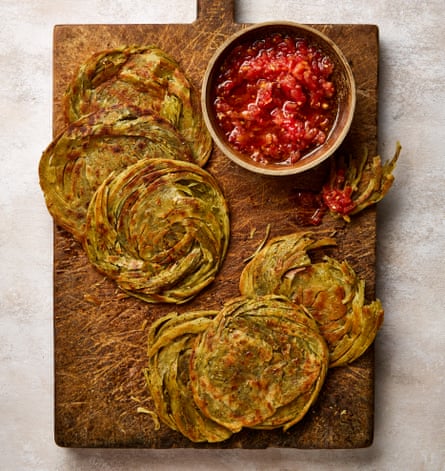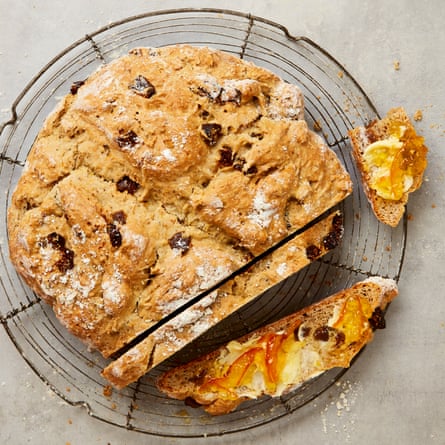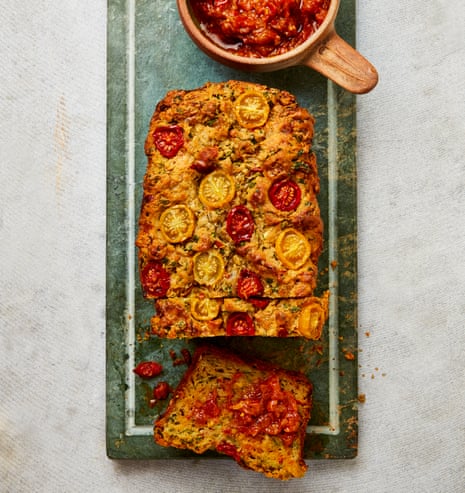Is everyone still feeding their starters? Has everyone perfected their sourdough? At one point, lockdown felt like one big, flour-covered experiment. Time (if not flour) was in abundance, so for many sourdough was the loaf of choice, and as as well as feeding ourselves, we also had to feed our demanding starters before they’d give anything back. I’m a complete bread head at the best of times, but, truth be told, at home I lean more towards the quicker flatbreads, soda breads and easy loaves. They don’t involve any yeast, so don’t need time to ferment, bubble and get to work. Maybe I’m just too greedy to wait, but time is in shorter supply now than it was a few months ago. Luckily, flour is back in abundance, so there is enough for all to have and share.
Tomato and courgette loaf with tomato chutney (pictured above)
This is somewhere between a veggie loaf and a bread, as perfect for brunch as it is for afternoon tea. The chutney is pretty special, so make more of it than you need here, and keep in a jar in the fridge, where it will last for at least a week: it’s particularly delicious paired with sharp cheese or all sorts of eggs.
Prep 30 min
Cook 2 hr 30 min
Serves 4-6
2 courgettes (350g), roughly grated
275g plain flour
2 tsp baking powder
½ tsp bicarbonate of soda
1½ tsp garam masala
1 tsp caster sugar
2 large eggs
60ml olive oil
70g Greek-style yoghurt
150g mature cheddar, roughly grated
6-7 tbsp (25g) roughly chopped coriander
75g mixed (red and yellow) cherry tomatoes, halved
For the tomato chutney
75ml olive oil
6 garlic cloves, peeled and crushed
45g fresh ginger, peeled and finely grated
2 red chillies (30g), finely chopped, seeds and all
1½ tbsp tomato paste
½ tsp turmeric
2 tsp garam masala
1½ tbsp caster sugar
750g tomatoes, cored and finely chopped
Salt and black pepper
Make the chutney first. Put four tablespoons of the oil in a large saute pan on a medium-high heat and, once hot, add the garlic, ginger and chilli, and cook, stirring occasionally, for two minutes, until fragrant. Add the tomato paste, spices and sugar, cook, stirring, for a minute more, then add the chopped tomatoes, a teaspoon of salt and a good grind of pepper. Bring to a simmer, then turn down the heat to medium and leave to cook, stirring regularly, for 45 minutes, until the tomatoes have broken down and the mixture is nice and thick. Spoon 150g of the chutney mix into a bowl, and leave both the chutney in the bowl and the pan to cool.
Heat the oven to 200C (180C fan)/390F/gas 6. Line a standard (1kg) loaf tin with a piece of greaseproof paper large enough to cover the bottom and sides.
Put the grated courgettes and half a teaspoon of salt in a bowl, mix to combine, then leave to steep for 20 minutes. Tip the courgettes on to a clean tea towel and wring out as much liquid as possible – you should be left with about 180g of strained courgette – and set aside.
Put the flour, baking powder, bicarb, garam masala, sugar and a teaspoon of salt in a large bowl and mix to combine.
In a second bowl, whisk the eggs, oil and yoghurt, then stir in the cheddar and coriander. Put this, the strained courgette and the reserved 150g tomato chutney in the flour bowl and mix gently to combine. Transfer to the lined loaf tin and smooth out the top. Arrange the halved cherry tomatoes cut side up on top, gently pushing them into the dough without fully submerging them.
Drizzle with the final tablespoon of oil, bake for 40 minutes, then remove from the oven and lower the temperature to 190C (170C fan)/375F/gas 5. Cover the loaf with foil, then return to the oven and bake for 45 minutes more, or until a skewer comes out clean from the centre. Leave to cool in the tin for at least 30 minutes, or longer, if time allows.
Cut the loaf into 2½cm slices. Spoon the chutney into a bowl, stir in the remaining tablespoon of oil and serve alongside the bread.
Za’atar paratha with grated tomato

There’s a bit of a knack to making these flaky south Asian flatbreads, but, once you get the hang of the process, they’re really not that complicated. Here, I’ve simplified the method by cutting the dough to create those flaky layers, rather than rolling it multiple times, as is traditional. Serve as a snack or part of a brunch spread, perhaps with some young, salty cheese alongside.
Prep 10 min
Cook 1 hr 20 min
Makes 6
270g plain flour
40g semolina
1 tsp salt
1 tsp caster sugar
75ml olive oil
140-160ml lukewarm water
3 tbsp za’atar
4 tbsp sunflower oil, plus extra for greasing
For the tomato
320g vine tomatoes (ie, about 3)
1 garlic clove, peeled and crushed
2 tbsp olive oil
Salt and black pepper
Put the flour, semolina, salt and sugar in a large bowl and use your fingers to mix it together. Add a tablespoon of the olive oil, using your hands to incorporate it, then slowly pour in the water, using your free hand to bring the dough together into a shaggy mass: add about 120ml to begin with, then slowly add more – you’ll need about 155ml in total, give or take, though add a little more if you think it needs it. The dough will seem quite wet at first, but that’s how it’s meant to be. Tip out the dough on to a clean work surface and knead for five minutes, until it’s smooth, pliable and not at all sticky. Transfer to a lightly oiled bowl, cover with a damp tea towel and leave to rest for about 20 minutes.
Meanwhile, use a box grater roughly to grate the tomatoes, discarding the skins –you should end up with about 220g grated flesh. Transfer the grated tomato to a sieve set over a bowl, leave to drain for five minutes, then discard the liquid and put the drained pulp in a bowl with the garlic, oil, a quarter-teaspoon of salt and a good grind of pepper.
In a small bowl, stir the za’atar into the remaining four tablespoons of olive oil and set aside.
Transfer the dough to a well-oiled surface and divide into six 80g balls. Working with them one at a time, and keeping the rest under a damp tea towel, use a well-greased rolling pin to roll out a dough ball as thin as it will go without tearing – about 1mm thick and 30cm in diameter (it’ll start to look a little transparent). Don’t worry if it’s not a perfect circle; it doesn’t need to be. Using a small, sharp knife, cut the circle into 1cm-wide strips, then drizzle over a tablespoon of the za’atar oil , using your hands or the back of a spoon gently to spread the oil all over the strips. Next, use your fingers gently to gather and push the strips together, so you end up with one long string of dough. Now, using your dominant hand, wrap the whole thing around the four fingers of your other hand and tuck the end through the centre, to form a round, so it looks a bit like a bird’s nest. Repeat with the remaining dough, making sure the work surface and rolling pin are well-oiled each time.
Put a medium frying pan on a medium heat (or use two pans to speed things up. While it’s heating up, use the greased rolling pin to roll one of the nests into a 10cm-12cm disc. Once the pan is hot, cook the paratha on one side for three minutes, then flip over and cook for three minutes more on the other side. Brush the top with about a teaspoon of sunflower oil, then flip again and cook for a minute. Brush the other side with another teaspoon of sunflower oil, then flip and cook for a minute more. Put the cooked paratha on a plate, cover with a tea towel (this will help keep it nice and soft), and repeat with the remaining dough.
Transfer the parathas to a platter or board and serve with the grated tomato alongside. If you’re not eating them right away, wrap the parathas really well, and eat them later, at room temperature or gently reheated.
Soda bread with figs, star anise and orange

The spices and sticky figs mean this loaf is a touch on the sweet side. To counter and complement that, I like to serve it with softened, salted butter and some bitter marmalade.
Prep 15 min
Cook 1 hr
Serves 6
180ml whole milk
240g Greek-style yoghurt
1 large egg
1 tbsp finely grated orange zest
515g plain flour
2 tsp ground star anise
1 tsp ground cinnamon
40g caster sugar
1 tsp bicarbonate of soda
½ tsp baking powder
1 tsp salt
70g fridge-cold unsalted butter, cut into 1½ cm cubes
150g soft dried figs, stalks removed and discarded, flesh cut into 1cm cubes
Heat the oven to 200C (180C fan)/390F/gas 6, and line a medium baking tray with greaseproof paper.
In a medium bowl, whisk the milk, yoghurt, egg and orange zest until well combined, then set aside.
In a large bowl, mix the flour, spices, sugar, bicarb, baking powder and salt, then rub in the cubed butter with your hands until the mix resembles coarse crumbs similar to large couscous. Stir in the chopped figs, add the yoghurt mixture and stir to gently combine – do not overmix it: you want the ingredients just to come together. Note that the dough will be very sticky.
With lightly floured, clean hands, transfer the dough to the prepared tray and shape it into a rough, 18cm-diameter circular mound similar to a loaf of sourdough. Use a sharp knife gently to score a cross in the top (don’t worry if it’s not perfect), then bake for 45 minutes, until nicely browned and a skewer comes out just clean. Transfer to a wire rack to cool for about 45 minutes, then slice and serve.

Comments (…)
Sign in or create your Guardian account to join the discussion